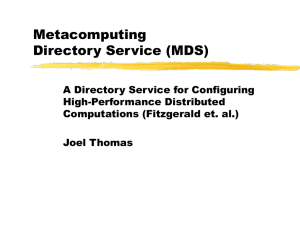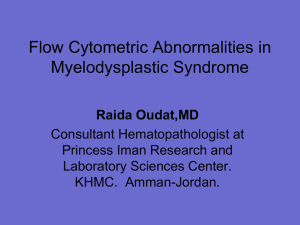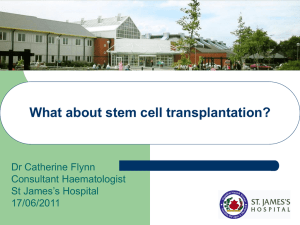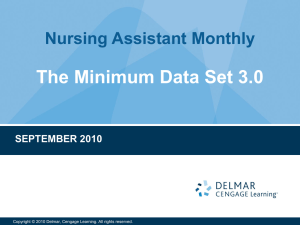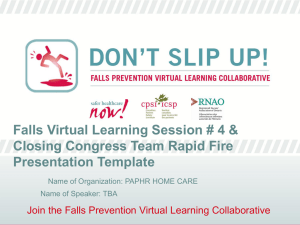MDS - Knowledgevision
advertisement
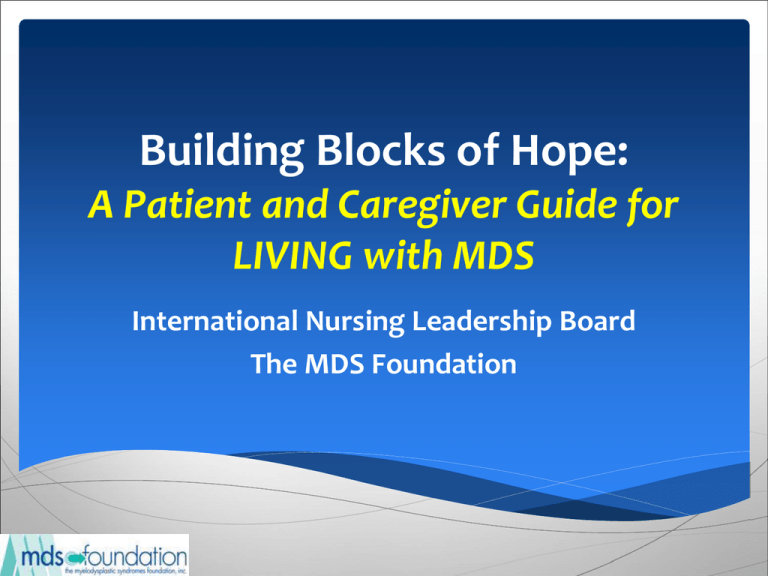
Building Blocks of Hope: A Patient and Caregiver Guide for LIVING with MDS International Nursing Leadership Board The MDS Foundation The Building Blocks of Hope Answering Common Questions About MDS Understanding the Diagnosis of MDS How is MDS diagnosed? What are my treatment options? What are the common side effects of treatment, and what can be done to control them? What new treatments are on the horizon to treat patients with MDS? What are the consequences of blood transfusion? Should I receive iron chelation therapy? How do I select a bone marrow transplant center? What can I do to keep myself healthy? Kurtin, et al. (2012) CJON Tools and Strategies for Success Understand the disease Know your IPSS and now IPSS-R risk category Ask questions about treatment options • Schedule • Possible side effects • Strategies for managing them Consider lifestyle, transportation Ask for help Learn to “track” your progress • Laboratory measures, bone marrow results What is MDS? The Myelodysplastic Syndromes (MDS) represent: a group of bone marrow cancers clonal (one cell line – in this case myeloid) hematologic stem cell malignancies (cancerous cells that originate in the bone marrow) • MDS is not one disease rather a group of diseases originating in the bone marrow with variations in clinical findings, disease trajectory, and treatment recommendations Kurtin. Clin J Oncol Nurs. 2006;10:197-208. List et al. In: Lee et al, eds. Wintrobe’s Clinical Hematology. 11th ed. 2004:2207-2234. Steensma and Bennett. Mayo Clin Proc. 2006;81:104-130. What is MDS? What happens: • Cells are abnormal in shape/size: Dysplastic • Cells don’t work well: lead to ineffective hematopoiesis • Result is cytopenias – low blood counts • There is a risk of developing leukemia in some cases (leukemic transformation) In general, as the disease progresses, bone marrow function declines Kurtin. Clin J Oncol Nurs. 2006;10:197-208. List et al. In: Lee et al, eds. Wintrobe’s Clinical Hematology. 11th ed. 2004:2207-2234. Steensma and Bennett. Mayo Clin Proc. 2006;81:104-130. All Blood Cells Begin as Hematopoietic Stem Cells Natural killer (NK) cells Healthy Bone Marrow Lymphoid progenitor cell T lymphocytes Neutrophils Basophils B lymphocytes Eosinophils Hematopoietic stem cell Multipotential Myeloid stem cell progenitor cell Monocytes/ macrophages Platelets Red blood cells Stem cell basics. National Institutes of Health Stem Cell Information Web site. In MDS, Defects in the Bone Marrow Environment and Cells Lead to Ineffective Hematopoiesis MDS Bone Marrow Natural killer (NK) cells Lymphoid progenitor cell T lymphocytes Neutrophils Basophils B lymphocytes Eosinophils Hematopoietic stem cell Multipotential Myeloid stem cell progenitor cell Monocytes/ macrophages Platelets Intrinsic and extrinsic factors create defects in normal hematopoiesis Red blood cells Immature precursor cells Stem cell basics. National Institutes of Health Stem Cell Information Web site. Peripheral cytopenias Hypercellular bone marrow How Common is MDS? New cases per year ~ approximately 10- 15,000 Overall prevalence is estimated to be 35,000-50,000 Factors contributing to potential rise in incidence and prevalence • • • • Aging population Improved recognition of disease and diagnostic capabilities Evolving treatment options Secondary malignancy in patients previously treated with chemotherapy or radiotherapy Rollison et al. ASH 2006. Abstract 247. Ma et al. Cancer. 2007;109:1536-1542. NCCN Clinical Practice Guidelines in Oncology™: Myelodysplastic Syndromes—v.2.2010. Who Gets MDS and Why? Most often we don’t know the cause More common in certain populations: Older age Male gender Immune dysfunction Rare inherited congenital abnormalities 40 Percentage • • • • Most Common in Patients 65-80 years of age 35 30 25 20 15 10 5 0 • (Fanconi’s anemia, Familial MDS), < 40 40–49 50–59 60–69 70–79 Age in 10-Year Blocks Some cases are common with certain exposures: • • • • Chemotherapy, Environmental/occupational Tobacco (benzene) Ionizing radiation List et al. In: Lee et al, eds. Wintrobe’s Clinical Hematology. 2003:2207. Pederson-Bjergaard et al. Hematology. 2007;392-397. 80+ What Symptoms are Common with MDS? Many patients are asymptomatic Patients commonly present to PCP or ED • For routine follow-up or screening • Screening labs with findings of cytopenias • Due to symptoms Most common presenting symptoms are associated with one or more cytopenias • Fatigue, shortness of breath, palpitations—anemia • Fever, recurrent or prolonged infections—neutropenia • Bruising, petechiae, or bleeding—thrombocytopenia Kurtin. Oncology: Nurse Edition. 2007;21:41-48. How Is MDS Diagnosed ? Peripheral blood counts + reticulocyte count Bone marrow biopsy and aspiration Hematopathology Bone marrow blasts (%) Cellularity Dysplastic features Cytogenetics Iron stain Reticulin stain Additional tests Iron saturation, ferritin B12, folate levels EPO level Hemolysis screen TSH, testosterone Renal and hepatic profiles Establish diagnosis of MDS Determine subtype FAB/WHO Estimate prognosis IPSS score EPO = erythropoietin; FAB =French-American-British; WHO = World Health Organization; TSH = thyroid; IPSS = International Prognostic Scoring System. How is MDS Classified? Cell Type and Shape (Morphology) • French American British Classification System (FAB) • World Health Organization (WHO) Disease related factors associated with risk/prognosis • International Prognostic Scoring System (IPSS) • Number of blasts, number of cytopenias, specific chromosome abnormalities Myelodysplastic Syndromes: Classification Systems FAB BLAST % (BM/PB) WHO WHO 2008 DYSPLASIA Refractory anemia (RA) RA Myelodysplastic syndromes, unclassified (MDS-U) Refractory cytopenia with multilineage dysplasia (RCMD) Del(5q) RC with unilineage dysplasia (RCUD) RA Refractory neutropenia Refractory thrombocytopenia RCMD Isolated del(5q) MDS-U Erythroid Nonerythroid Nonerythroid Erythroid + other Erythroid + megakaryocytic Unilineage + pancytopenia or RCMD/RCUD with 1% PB blasts All: < 5/≤ 1 Refractory anemia with ringed sideroblasts (RARS) RARS RCMD-RS RARS RCMD-RS Erythroid only Erythroid + other (all > 15% RS) < 5/< 1 Refractory anemia with excess blasts (RAEB) RAEB-1 RAEB-2 RAEB-1 RAEB-2 ≥ 1 lineage ≥ 1 lineage 5–9/2–4 10–19/5–19 ± Auer rods RAEB in transformation Acute myeloid leukemia (AML) AML Myeloid ± other ≥ 20/— Chronic myelomonocytic leukemia (CMML) MDS/myeloproliferative disorder (MPD) CMML Juvenile MML (JMML) Atypical chronic myeloid leukemia (aCML) MDS/MPD-U MDS/myeloproliferative neoplasm (MPN) CMML JMML BCR-ABL–negative CML Variable > 1 × 109/L monocytosis All: < 20/— From: Ridgeway et al, 2012 MDS/MPD-U The Facts About MDS The average age at diagnosis is 73 years MDS remains an incurable malignancy for the majority of patients Allogeneic-HCT is the only potential “cure” The leading cause of death is the disease itself (~80%) Risk-stratified treatment strategies are key to optimal therapeutic outcomes Dayyani et al., 2010; Kurtin et al, 2012 IPSS Risk Categories Variable/Score 0 0.5 1.0 1.5 2.0 Marrow blasts (%) <5 5-10 --- 11-20 21-30* Karyotype Good Intermediate Poor Cytopenias 0/1 2/3 Risk Category Numeric Score Patient Distribution Median Survival† Evolution to AML Low 0 31% 5.7 years 9.4 Int-1 0.5-1.0 39% 3.5 years 3.3 Int-2 1.5-2.0 22% 1.2 years 1.1 High ≥ 2.5 8% 0.4 years 0.2 Life expectancy at 75 years US 11.2 years Life expectancy at 65 years US 17.7 years † Data generated prior to active therapies US Social Security Administration, 2009. Greenberg et al. Blood. 1997;89:2079 [published correction in Blood. 1998;91:1100]. * >20% blasts denotes AML IPSS-R 18 Databases -11 Countries , 7012 patients Austria Brazil Czech Rep France Germany Italy Japan Netherlands Scotland Spain USA Greeberg, P. on behalf of the IWG-PM – MDS Symposium, ASH December 2011 – with permission IPSS-R: Modified Cytogenetic Prognostic Subgroups Very Good: 60.8 months del(11q), -Y Good:48.5 months Normal, del(20q), del(5q) alone and double, del(12p) Intermediate: 24 months +8, 7q-, i(17q), +19, +21, any other single or double, independent clones Poor: 14 months der(3)q21/q26, -7, double including 7q-, complex (3 abnormalities) Very Poor: 5.7 months Complex (>3 abnormalities) Greenberg et al, Leuk Res. 2011;35:S6. Abstract 14 Schanz et. al., J Clin Oncol : 30:820, 2012 IPSS-R for MDS: Prognostic Score Values/Risk 0 1 1.5 1.5 Cyto Very Good Blasts <5% 5-10% Hgb >10 <10 Plt >100 ANC >0.8 Good 2.5 3.5 5 Int Poor Very Poor 11-30% <100 <0.8 Risk Groups 1. Very Low: 0-2 2. Good: >2-3.5 3. Intermediate: >3.5-5 4. High: >5-6 5. Very High: >6 *Preliminary data – final attributes and scores to be finalized by the IWG-PM Greenberg, P. on behalf of the IWG-PM – MDS Symposium, ASH December 2011 – with permission IPSS-R: Prognostic Subgroup Clinical Outcomes* 1 Very Low 2 Good 3 Intermediate 4 Poor 5 Very High OS 8.7 5.3 3.0 1.6 0.8 AML, 25% NR 10.7 4.0 1.4 0.8 * Medians, years *Preliminary data – final attributes and scores to be finalized by the IWG-PM Greenberg, P. on behalf of the IWG-PM – MDS Symposium, ASH December 2011 – with permission What Are the Current Treatment Options? Supportive care: Transfusions, growth factors REVLIMID® (lenalidomide) VIDAZA® (azacitidine for injection) Dacogen® (decitabine) Chemotherapy: Cytarabine, Clofarabine, Etoposide Bone marrow transplant Investigational agents FDA approved agents are limited Maximizing each option to its full benefit is critical Key Principles of Therapy in MDS MDS is not curable • Not every patient will have a complete response • Hematologic improvement, stable disease, and transfusion independence are good things Allogeneic bone marrow transplant remains the only potentially curative therapy Treatment goals have shifted From: improvement in blood counts, transfusion independence, delay in time to leukemic transformation To: Improved overall survival, Improved quality of life and minimal toxicity Individualized Treatment Treatment Triggers: Initiation of disease modifying therapy Transfusion dependence Progressive or symptomatic cytopenias Increasing blasts High-risk disease Individualized treatment selection Performance status (good vs poor) Comorbidities IPSS risk category (low/Int-1 vs Int-2/high) Low/Int-1: improve hematopoiesis Int-2/high: survival Primary vs secondary MDS Cytogenetic status (del[5q], complex karyotype) Lifestyle NCCN Clinical Practice Guidelines in Oncology: Myelodysplastic Syndromes—v.2.2011. Kurtin and Demakos. Clin J Oncol Nurs. 2010;14:3. doi:10.1188/10.CJON.E24-E39. Key Principles of Therapy in MDS Age alone should not exclude active therapies • Consider performance status and comorbidities Blood counts often get worse before they get better All active therapies for MDS require time to work (4-6 months of continued treatment) Strategies for pro-active management of side effects in the early phases of treatment are key to obtaining the best response Why Is Time Required? Consider What is Happening… …Before Treatment Begins Blood counts drop as MDS progresses, and normal blood cells are crowded out by abnormal stem cells in the bone marrow and blood Why Is Time Required? Consider What is Happening… …When Treatment is Initiated ANC, 109/L As the treatment “cleans” the marrow, blood counts may drop further. Patients may experience hematologic toxicities ANC (Neutrophil Granulocytes) 3.2 100% 2.7 80% ANC ref. value 2.2 60% 1.7 40% 1.2 20% 0.7 1 6 11 16 Treatment, weeks 21 0% ANC Mean ± 97.5 CI Sekeres MA, List AF. Clin Leuk. 2008;2:28-33. Why Is Time Required? Consider What is Happening… …As The Patient Begins to Respond ANC, 109/L The bone marrow begins to recover, allowing it to make healthy blood cells. Blood cell counts should rise and symptoms of MDS should improve ANC (Neutrophil Granulocytes) 3.2 100% 2.7 80% ANC ref. value 2.2 60% 1.7 40% 1.2 20% 0.7 1 6 11 16 Treatment, weeks 21 0% ANC Mean ± 97.5 CI Sekeres MA, List AF. Clin Leuk. 2008;2:28-33. Why Is Time Required? Consider What is Happening… …As The Response Continues ANC, 109/L Patient can be weaned from supportive care as a robust response sets in ANC (Neutrophil Granulocytes) 3.2 100% 2.7 80% ANC ref. value 2.2 60% 1.7 40% 1.2 20% 0.7 1 6 11 16 Treatment, weeks 21 0% ANC Mean ± 97.5 CI Sekeres MA, List AF. Clin Leuk. 2008;2:28-33. The Challenge is Getting Through the First Few Cycles Early toxicities may be difficult and/or discouraging for the patient… ANC, 109/L ANC (Neutrophil Granulocytes) 3.2 100% 2.7 80% ANC ref. value 2.2 60% 1.7 40% 1.2 20% 0.7 1 6 11 16 Treatment, weeks 21 0% ANC Mean ± 97.5 CI Sekeres MA, List AF. Clin Leuk. 2008;2:28-33. KEY PRINCIPLES OF THERAPY FOR MDS • Time is required for the best response : A minimum of 4-6 months ANC, 109/L • Cytopenias often get worse before they get better • There are strategies for getting through ANC (Neutrophil Granulocytes) 3.2 the initial cycles of therapy 2.7 • Dose modifications/delays ANC ref. value 2.2 • Supportive care 1.7 • Setting expectations 1.2 0.7 1 6 Working together for 11 16 21 Treatment, weeks ANC Mean ± 97.5 CI 100 % 80% 60% 40% 20% 0% Sekeres MA, List AF. Clin Leuk. 2008;2:28-33. the best response Before Treatment Begins When Treatment is Initiated As The Response Continues As The Response Continues Mechanisms of Action of Therapies Under Investigation AGENT TARGET MOA TRIAL/POPULATION RESPONSE GRADE 3/4 AES ARRY-614a P38/Tie-2 Antineoplastic, antiinflammatory, and antiangiogenic activity Phase I/low or Int-1 risk (N = 100) – – Entinostat (SNDX275/MS-275)b Histone DAC Class 1 HDAC1 and HDAC3 inhibitor Combination with azacitidine; phase III/high risk (N = 150)c HR and CyR did not • Thrombo: 63% differ between • Fatigue 23% AZA/Pbo versus AZA/entinostat Erlotinibd EGFR signaling leads to DNA synthesis and proliferation Tyrosine kinase inhibitor that blocks EGFR signaling Phase II/Int-2 and high risk (N = 24)e ORR: 17% • Diarrhea: 21% • Thrombo: 17% • Rash: 17% Everolimus (RAD-001)f mTOR Inhibitor of mTOR that induces G1 arrest Phase II/low and Int-1 risk (not yet recruiting)g – – Ezatiostath GST P1-1 Stimulates proliferation of myeloid precursors Phase I/Int-2 (N = 45) HI: 38% • Neutropenia: 7% ON-0110.Nai Polo-1 kinase, PI3K, AKT Inhibits mitotic progression and induces apoptosis Phase II/Int-1, Int-2, high risk (N = 10)j ORR: 50% • GI: 10% • Dysuria: 10% • Fatigue: 10% • Epistaxis: 10% • No heme toxicities Panobinostat (LBH589)k Histone DAC Pan DAC inhibitor, inhibits differentiation and induces apoptosis Phase II/relapsed or refractory MDS (N = 10)l 70% had stable disease • Thrombo: 80% • Neutropenia: 70% • Leukopenia: 60% • Anemia: 50% • Febrile neutropenia: 20% From: Ridgeway et al, 2012, CJON Trilineage Response Following 4 Cycles of Azacitidine Kurtin, S. et al. (2012) Digital Object Identifier:10.1188/12.CJON.S1.23-35 Patient Response Over 10 Years of Lenalidomide Treatment Sustained Moderate But Asymptomatic Cytopenias–A New “Normal” Kurtin, S. et al. (2012) Digital Object Identifier:10.1188/12.CJON.S1.23-35 Sub-Group Analysis of the AZA-001: Elderly patients >75 years with high risk disease 87 elderly > 75 years High risk disease: IPSS: Int-2 or High AZA significantly improved OS compared to BSC 2 year OS rates 55% vs 15% (p<0.001) AZA generally well-tolerated Adverse events most common in the first 2 cycles AE (grade 3/ 4 Cycle1-2 Cycle 3-4 Cycle 5-6 AZA BSC AZA BSC AZA BSC Anemia (%) 2 1 0 1 2 0 Neutropenia (%) 15 6 8 3 7 2 Thrombocytopenia (%) 14 10 8 2 5 0 Fatigue (%) 0 0 1 1 1 0 Pyrexia (%) 0 0 1 1 1 0 Seymour et al. 2010, Crit Rev Onc/Heme 76;218-227. MDS and low blood counts Anemia • Too few RBC to carry hgb and supply oxygen to the body • The MOST COMMON blood disorder w/MDS • Symptoms: fatigue, SOB, headaches, fast heart rate Neutropenia • Increases the risk of bacterial infections • Skin, sinus, lung, urinary • Symptoms: fever Thrombocytopenia • Bruising, prolonged bleeding, bleeding problems which can be severe Tracking Your Progress Kurtin, S. et al. (2012) Digital Object Identifier:10.1188/12.CJON.S1.23-35 Tools for Managing Neutropenia Monitoring of blood counts weekly for the first 8 weeks of treatment, then a minimum of monthly or as clinically indicated Patients receiving active therapies may require drug holiday and dose adjustment Early recognition of infections Administration of recombinant granulocytic growth factors Same-day administration with azacitidine or decitabine not recommended No contraindication to same-day administration with thalidomide and lenalidomide Antimicrobial therapy for active infections To avoid resistance, prophylactic antibiotics are not generally recommended Kurtin and Demakos. Clin J Oncol Nurs. 2010;14:3. doi:10.1188/10.CJON.E24-E39. Scott and Deeg. Annu Rev Med. 2010;53:345-358. Kurtin. Oncology: Nurse Edition. 2007;21:41-48. Tools for Managing Thrombocytopenia Monitoring of blood counts weekly for the first 8 weeks of treatment, then a minimum of monthly or as clinically indicated Patients receiving active therapies may require drug holiday and dose adjustment Platelet transfusions based on risk of bleeding Careful monitoring of concomitant medications with antiplatelet effect Thrombopoietin-stimulating hormones are in clinical trials Kurtin and Demakos. Clin J Oncol Nurs. 2010;14:3. doi:10.1188/10.CJON.E24-E39. Scott and Deeg. Annu Rev Med. 2010;53:345-358. Kurtin. Oncology: Nurse Edition. 2007;21:41-48. Tools for Managing Common Gastrointestinal Toxicities Nausea and Vomiting Diarrhea • Ensure baseline and ongoing renal and hepatic function assays • Evaluate for infectious etiology • Adequate hydration • Premedicate for anticipated nausea/vomiting • Bowel regimen as indicated • Antidiarrheal medications • Evaluate concomitant medications • Dietary measures/consultation • Dietary measures/consultation • Encourage adequate hydration Constipation • Adequate hydration • Dietary measures/consultation Kurtin and Demakos. Clin J Oncol Nurs. 2010;14:3. doi:10.1188/10.CJON.E24-E39. Scott and Deeg. Annu Rev Med. 2010;53:345-358. Kurtin. Oncology: Nurse Edition. 2007;21:41-48. Addressing Injection Site Reactions Injection site reactions are common and can vary greatly from patient to patient Regardless of appearance (anything from a small bruise to a large, tender, red welt), injection site reactions usually disappear after several days and normally do not scar If symptoms of discomfort or redness at the injection site develop, a cool or warm compress may be applied for 15 minutes at a time (depending on the patient’s tolerance to temperature) to help relieve symptoms Preparing for the Injection Review history: medications: other injectable medications, anti-platelet/anticoagulation medications, and thrombocytopenia Injection site selection: adequate adipose tissue (pinch and inch), Rotation of sites – abdomen, posterior upper arms, upper outer aspects of the thighs: Avoid areas prone to friction – belt-line, seat belt region. Avoid areas with scarring, birth marks, inflammation, impaired skin integrity, Avoid friction to site: wear loose fitting clothing, avoid rubbing the site immediately after injection. Apply cool compress 4 hours after injection – do not apply immediately as this may interfere with drug absorption. Injection Technique: The Air Sandwich “ Air Sandwich” 0.5-1.0 ml air behind the drug Injectable Azacitidine Fresh 25 gauge needle – not purged Air ahead of the drug Call Doctor Y or Nurse XX @ 555-123-1111 if you have any of these changes Fevers above 101.5° or shaking chills Sudden onset of shortness of breath or chest pain (call 911) Skin changes Bruises Tiny, red, pinpoint spots on your skin A new or worsening rash Head or vision change Bad headaches Changes in how well you see Feeling confused or very sleepy Bleeding Bleeding that does not stop after a few minutes Changes when you go to the bathroom Visible blood or a red to pink color of the urine Black or bloody stools Uncontrolled nausea, vomiting, diarrhea, or constipation www.cancer.gov/help Tools for Management of Fatigue Individualized assessment Sleep, nutrition, depression, medications, activity, comorbidities Individualized Interventions Balance between activity enhancement and energy conservation Psychosocial interventions Nutrition consultation Sleep evaluation Pharmacologic interventions Psychostimulants, sleep medications Transfusion Risks: Iron Overload Each unit of PRBC adds 250 mg of unexcretable iron into the patient’s blood • At 20-40 RBC transfusions (5-10 g iron) • Elevated serum ferritin (1,000-2,000 mg/L), liver, and/or cardiac iron Iron accumulation results in end-organ damage • • • • • Heart: CHF Liver: elevated LFTs, hepatomegaly, pain Endocrine glands: diabetes Bone marrow: dysfunctional hematopoiesis Brain: confusion, dizziness Malcovati et al. J Clin Oncol. 2005;23:7594-7603. Jabbour et al. Oncologist. 2009; Kurtin. Oncology: Nurse Edition. 2007;21:41-48. Which Patients With MDS Are Likely to Benefit Most From Management of Iron Overload? Transfusion status • Transfusion dependence • Requiring 2 units/month for > 1 year • Received 20–30 packed RBC units Serum ferritin • 1,000 ug/L (MDS Foundation) • > 2,500 ug/L (NCCN) • Or evidence of significant tissue iron overload with continued transfusion dependence MDS risk • IPSS: Low- or int-1 • WHO: RA, RARS, and 5q Patient profile • • • • Candidates for allografts Life expectancy > 1 year Free of comorbidities that limit prognosis A need to preserve organ function Jabbour et al. Oncologist. 2009;14:489-496. NCCN Clinical Practice Guidelines in Oncology™: Myelodysplastic Syndromes—v.2.2010. Options for Treatment of Iron Overload Parameters Route Schedule Potential Side Effects Website Deferoxamine (Desferal) Deferasirox (Exjade) Deferiprone (Ferriprox) Phlebotomy Intramuscular, Intravenous, Subcutaneous Administered over 824 hours, 5-7 days/week Oral Oral Venipuncture Once a daily Three times daily 1-2 weekly GI, hepatic disturbances myelosuppression Non-invasive Low blood pressure www.ferriprox.com n/a Ocular, auditory, Renal, hepatic, localized site injection rash, reaction, allergic myelosuppression, reaction, growth and GI disturbances skeletal abnormalities www.desferal.net Shah et al. (2012) CJON www.us.exjade.com What Can I do To Stay Healthy? Balanced Diet Daily Activity/Exercise Avoid Infection Avoid Bleeding Continue to Enjoy Things You Love - LIVE Get Enough Rest Take Advantage of Available Resources Ask for Help When Needed Be an Active Participant in Building Hope Supporting the MDS Patient, their Caregivers and Health Care Providers Effective patient, caregiver, and HCP communication will promote patient and caregiver participation in the decision making process and self-care A number of Web-based resources provide resources for patients, caregivers and health care providers http://cjon.sup.mds-foundation.org MDS-Specific Organizations (alphabetical order) Life Beyond Limits http://mdslifebeyondlimits.org Brings together an independent group of MDS experts to raise awareness of ageism in access to care for patients with MDS MDS Beacon http://mdsbeacon.com Objective and unbiased news and other information related to MDS MDS-Specific Organizations (alphabetical order) MDS Foundation http://mds-foundation.org Multidisciplinary, international, nonprofit organization dedicated to the education of professionals, patients, and caregivers; facilitation and support of clinical trials; and development and support of patient advocacy groups United Kingdom MDS Patient Support Group http://mdspatientsupport.org.uk Offers support, information, referral advice, and patient information in the United Kingdom MDS Resources For Patients and Professionals Aplastic Anemia & MDS International Foundation, Inc. • Telephone: 1-800-747-2820 • Internet Address: www.aamds.org The Leukemia & Lymphoma Society • Telephone: 1-914-949-5213 (home office) • 1-800-955-4572 (information, resources number) • Internet Address: www.leukemia-lymphoma.org The MDS Foundation International Nurse Leadership Board http://mds-foundation.org/nursing-leadership-board-nlb/ Erik Aerts, RN Zürich, Switzerland Louise Arnold, RN – Co-chair Leeds, United Kingdom Lotta Billgert, RN Stockholm, Sweden Angelika Bitter, RN Dresden, Germany Claudia Boglione, RN Florence, Italy Núria Borràs, RN Barcelona, Spain Karen Campbell, BSc(Hons), RN, MN, PGcert Edinburgh, Scotland, United Kingdom Debbie Carr, RN, Ba OH&S Newcastle, Australia Nicole Crisp, MN, NP Edmonton, Alberta, Canada Erin Demakos, RN, CCRN – Co-chair New York, New York, United States Corien Eeltink, RN, MA ANP Amsterdam, The Netherlands Lenn Fechter, RN Stanford, California, United States Janet Hayden, RN, BSc(hons), MPH – Co-chair London, United Kingdom Sandra E. Kurtin, RN, MS, AOCN, ANP-C – Co-chair Tucson, Arizona, United States Petra Lindroos Kolqvist, RN Goteborg, Sweden Arno Mank, RN Amsterdam, The Netherlands Cindy Murray RN, MN, NP-adult Toronto, Ontario, Canada Phyllis Paterson, RN, RSCN, Dip Onc Cambridge, United Kingdom Jean A Ridgeway, MSN, APN, NP-C, AOCN Chicago, Illinois, United States Jayshree Shah, APN-C, AOCN, RN, MSN, BSN, BS, CCRP Hackensack, New Jersey, United States Natalie Singer, MSc, RN,BSc(Hons) Glasgow, Scotland, United Kingdom Mary L. Thomas, RN, MS, AOCN San Francisco, California, United States Sara M. Tinsley, ARNP, AOCN Tampa, Florida, United States Passion for the Patients LIVING with MDS Discussion Questions Sharing

